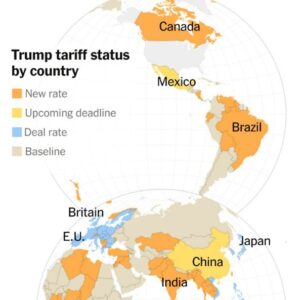Trump Meets with Xi, Declares Immediate Cut to Tariffs by Josh Chin Follow and Meridith McGraw
U.S.-China summit offers relief to both sides while high-stakes rivalry carries on. President Trump and Chinese leader Xi Jinping emerged from their first face-to-face meeting in six years with a temporary truce in the bruising trade fight between the two superpowers. Their agreement lowers immediate tensions between the U.S. and China, which have been locked for months in a bitter struggle over trade and technology that has hurt both their economies. The agreement includes a reduction in stiff U.S. tariffs on Chinese goods in exchange for a pledge by China to crack down on the trade in the chemicals used to produce fentanyl. China also promised to ease the exports of rare earths—minerals that Western manufacturers rely on to make a range of goods. And Beijing promised to buy “tremendous amounts” of American soybeans. Trump Meets With China’s Xi, Declares Immediate Tariff Cut – WSJ



